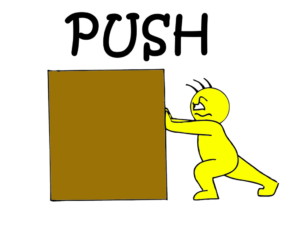FORCE AND PRESSURE
Force
A push or pull of an object is called a force. The interaction between two objects arises force. Force has both magnitude and direction.
- Force can move a body initially at rest.
- Force can bring a moving body to rest.
- Force can change the direction of a moving body.
- Force can change the speed of a moving body.
Push
A push is a force exerted far from the body, e.g.: kicking a football.

Pull
A pull is a force exerted toward the body, e.g.: drawing a bucket of water from a well.
There are two types of forces:
- Contact force
- Non-contact force
1 Contact force
A contact force requires physical contact between two different bodies. For example: friction between your feet and the ground can be present.
- Muscular force
Muscular force is a type of contact force. When any force applied by using of muscles like arms or legs is known as muscular force.
- Friction force
Frictional force always acts between two moving objects, which are in contact with one another. Frictional force always acts opposite to the direction of motion.
2 Non-contact force
A non-contact force requires no physical contact between two different bodies. For example: magnetic force between two magnets can happen when the magnets are near but not touching.
- Magnetic force
The attraction or repulsion force exerted by a magnet is called magnetic force. Magnetic force is a non-contact force. (e.g.; iron, nickel, steel and cobalt).
- Electrostatic force
The electrostatic force is an attractive as well as repulsive force caused by the electric charged particles. (e.g.: blow up a balloon and tie the end. Rub the balloon on your head until your hair sticks up to create a static charge).
- Gravitational force
It is a kind of attractive force that comes into play because of the mass of a body. (e.g.; earth attracts balls towards it with gravitational force).
Pressure
The force acting per unit area of surface is called pressure.
Pressure= force/area on which it acts.
The unit of pressure is Newton per square meter(N/m2), which is also known as Pascal.
Liquids exerts pressure on the walls of the container.
Pressure exerted by liquids increases with depth.
Atmospheric pressure
The atmospheric air extends up too many kilometers above the surface of the earth. The pressure exerted by the air is known as atmospheric pressure.
EXAM RELATED QUESTIONS
1. What is the name of the instrument used to measure atmospheric pressure?
Ans. Barometer.
2. Give two example of contact force?
Ans. Muscular force
Friction force
3. How do fluids exert pressure?
Ans. Fluids exert pressure in all direction. Fluids also exert pressure on the wall of the container that hold them.
4. How does an applied force changes the speed of an object?
Ans. If the applied force is in the direction of motion, the speed of the object increases. But if the force applied in the direction opposite to the motion, then it decreases the speed of the object.
5. What is the effects of force on an object?
- Ans. Force can change the state of motion of an object.
- Force changes the speed of a moving object.
- Force can change the shape of an object.
- Why does the shape of the tooth paste tube change when we squeeze it?
Ans. The shape changes because our finger applies forces on the tube.
7. Which force can be used to gather iron pins scattered on the floor?
Ans. Magnetic force can be used to gather iron pins scattered on the floor.
8. Give one practical application of magnetic force?
Ans. The closing of door of refrigerator works on the application of magnetic force.
9. Why do balloons expand when filled with air?
Ans. Air exerts pressure on the inner walls of balloons causes it to expand and get inflated.
10. why water comes out more slowly from an upstairs tap than from a similar tap downstairs?
Ans. This is so because water pressure is less in the upstairs tap due to lesser depth.
